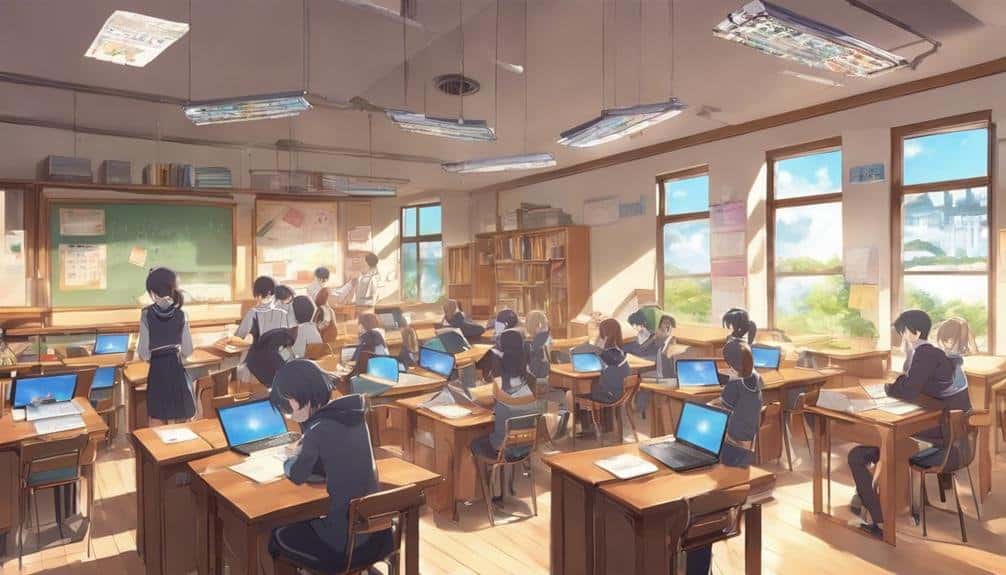Blended Learning: Combining Traditional and Digital Education
Blended learning has been steadily gaining traction in educational settings, offering a unique combination of traditional teaching methods with digital tools and resources.
The integration of face-to-face instruction with online platforms presents a promising approach to cater to diverse learning styles and preferences.
As educators navigate this evolving landscape, it becomes essential to explore the nuances of how this hybrid model can enhance student learning outcomes and classroom dynamics.
By examining the benefits, strategies, and outcomes associated with blended learning, a thorough understanding of its potential to transform education emerges, prompting a closer examination of its practical implications.
Key Takeaways
- Blended learning enhances engagement and academic success.
- It combines traditional teaching methods with digital resources.
- Personalized learning experiences are promoted through interactive content.
- Seamless integration of technology improves the classroom experience.
Benefits of Blended Learning
Combining traditional classroom instruction with online resources, blended learning offers a unique approach to education that has been shown to enhance student engagement and learning outcomes. One of the key benefits of blended learning is the increased interaction it fosters between students and teachers. By incorporating online tools and resources, students have the opportunity to engage with course materials in various formats, such as videos, interactive quizzes, and discussion forums. This increased interaction not only caters to different learning styles but also allows for more personalized learning experiences.
Additionally, blended learning enables educators to tailor instruction to individual student needs. Through online assessments and data analytics, teachers can track student progress more effectively and provide targeted support where necessary. This personalized approach helps students stay motivated and engaged in their learning journey. Research has shown that personalized learning experiences lead to improved academic performance and a deeper understanding of the subject matter.
Essentially, the benefits of blended learning extend beyond the traditional classroom setting, offering a dynamic and effective educational model for the modern learner.
Student Engagement in Blended Learning
The integration of traditional classroom methods with digital tools in blended learning environments has been found to greatly impact student engagement levels. Interactive activities play a vital role in enhancing student engagement by providing hands-on learning experiences that cater to different learning styles. These activities stimulate students' interest and encourage active participation in the learning process.
Additionally, virtual collaboration tools enable students to interact with their peers and instructors, fostering a sense of community and teamwork in a digital setting. This collaborative environment not only enhances engagement but also promotes critical thinking and problem-solving skills as students work together to achieve common goals. Research indicates that students are more motivated and committed to their studies when they can actively participate in discussions, group projects, and virtual simulations.
Achieving Academic Success With Blended Learning
Achieving academic success through blended learning involves leveraging a balanced integration of traditional teaching methods and digital resources to enhance learning outcomes and student performance. By combining the best of both worlds, students can benefit from personalized learning experiences, interactive content, and immediate access to a wealth of information. To illustrate this further, let's examine a comparison between traditional study techniques and those enhanced by digital resources:
| Traditional Study Techniques | Digital Resources |
|---|---|
| Note-taking during lectures | Online interactive quizzes |
| Textbook readings | Educational videos and animations |
| Group discussions | Virtual reality simulations |
| Flashcards for memorization | Educational apps for practice |
Research indicates that students who engage with a blend of traditional and digital learning methods tend to exhibit higher levels of academic performance. This combination allows for a more dynamic and adaptive approach to education, catering to diverse learning styles and enhancing overall comprehension and retention of material.
Strategies for Implementing Blended Learning
Implementing a strategic framework for blended learning involves the meticulous integration of traditional pedagogical methods with digital technologies to optimize educational outcomes. One of the primary challenges faced during the implementation of blended learning is ensuring seamless technological integration. This requires institutions to invest in robust infrastructure, provide training for educators on effectively using digital tools, and guarantee access to devices and reliable internet connectivity for all students.
To address implementation challenges, it is essential to develop a clear roadmap outlining the goals, timeline, and responsibilities associated with the adoption of blended learning. Establishing measurable objectives and regularly monitoring progress can help identify issues early on and make necessary adjustments. Additionally, fostering a culture of innovation and continuous improvement within the educational institution can facilitate a smoother shift to blended learning.
Moreover, promoting collaboration among educators, students, and technology specialists can enhance the effectiveness of blended learning initiatives. By encouraging open communication and sharing best practices, educational institutions can create a supportive environment conducive to successful technological integration and improved learning outcomes.
Enhancing Classroom Experience Through Blended Learning
By seamlessly integrating traditional teaching methodologies with digital resources, educators can enrich the classroom experience and enhance student engagement through blended learning. One way to achieve this is by incorporating interactive activities that leverage technology integration. These interactive activities can range from online quizzes and simulations to virtual field trips and collaborative projects using digital tools. By implementing such activities, educators can create a more dynamic and engaging learning environment that caters to different learning styles and preferences.
Technology integration in the classroom not only enhances the delivery of content but also provides opportunities for personalized learning experiences. For example, adaptive learning platforms can adjust the level of difficulty based on individual student performance, ensuring that each student receives targeted support. Additionally, digital resources offer access to a vast array of multimedia content that can supplement traditional teaching methods and make learning more interactive and engaging.
Conclusion
To summarize, blending traditional and digital education through blended learning offers numerous benefits for student engagement and academic success. By implementing effective strategies, educators can enhance the classroom experience and create a dynamic learning environment.
How can we continue to innovate and adapt to meet the changing needs of today's learners in this rapidly evolving educational landscape?







